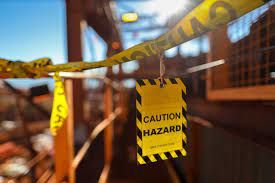- Home
- About Us
- Industry
- Services
- Reading
- Contact Us
The Global Hazard Control Market is expected to foresee significant growth. North America to hold a significant share!
Author: Vikas Kumar
September 14, 2022

A Hazard Control is a program that consists of all necessary steps to protect workers from exposure to a substance or system or training and procedures required to monitor worker exposure and their health to hazards such as chemicals, materials or substances, or other types of hazards such as noise and vibration also needed to be controlled within the industry. In addition, risk assessment is involved to evaluate and prioritize the hazard and risk. Additionally, the major factors responsible for the growth of the hazard control market are stringent norms for industrial safety, the development of unconventional hydrocarbon resources, and growing environmental and human resource concerns for human resources safety in industries. The global Hazard Control Market is expected to witness a CAGR of around 6% during the forecast period (2022–2028).
However, Covid – 19 has devasted the global economy due to which many sectors experienced a downfall as the demand for hazard control equipment got reduced within the industries due to their shutdown. But as the marine, oil & gas, petrochemical, and many others have been in process for a certain period, the concern towards human safety is gradually increasing to prevent human loss which is being into account with the help of hazard control monitoring devices depending upon the need of the industry.
For a detailed analysis of the global Hazard Control market browse through – https://univdatos.com/report/hazard-control-market/
Based on protection, the market is fragmented into fireproof/explosion-proof, intrinsic safety, and others. In 2020, the intrinsic safety segment is seen as prominent in the growth of the hazard control market. Intrinsic Safety (IS) is an approach to the design of equipment going into hazardous areas. The idea is to reduce the available energy to a level where it is too low to cause ignition. That means preventing sparks and keeping temperatures low. In addition, IS devices have widespread application across all industries and in all types of hazardous divisions and zone classifications. Furthermore, increasing industrialization in the Asia Pacific will drive the demand for such devices during the forecast period.
Based on product, the market is fragmented into motors, servo valves, sensors and actuators, drives, and others. In 2020, the motors segment is considerably going to grow in the hazard control market. Motors are utilized in a variety of applications, including industrial pumps, fans, and blowers. In addition, motors can operate in hazardous conditions, such as potentially explosive atmospheres, highly corrosive surroundings, and damp environments. As a result, the growing demand for motors from several Industries is expected to boost the market growth of hazard control during the forecasted period.
Based on application, the market is fragmented into oil & gas, metals and mining, chemicals and pharmaceuticals, packaging, aerospace and defense, and others. In 2020, the oil and gas segment is going to see a lucrative CAGR for the growth of the hazard control market. A focus on environmental protection and growing demand for hazard control from the oil & gas and chemical sectors is expected to drive demand for the hazard control market. In addition, governments and ruling authorities’ strict rules and regulations on industrial safety, along with the chemical and oil and gas industry’s adoption of unconventional processing methods, are driving the global demand for hazard control during the forecasted period.
Request for a Sample of the report browse through – https://univdatos.com/get-a-free-sample-form-php/?product_id=24606
For a better understanding of the market adoption of hazard control, the market is analyzed based on its worldwide presence in the regions such as North America; Europe; Asia-Pacific; and the Rest of World. North America is likely going to dominate the hazard control market during the forecasted period. As many top hazard control market companies such as Siemens AG and Rockwell Automation, Inc. have implemented strict occupational safety regulations to limit the number of incidents, particularly on construction sites. The hazard control market is gaining traction due to its contribution to environmental protection. In addition, the resurgence of the mining industry in North America is expected to present attractive prospects for companies in the hazard control market. The development of unconventional hydrocarbon resources in the region, such as tight oil and shale gas, is expected to drive the hazard control market forward. Furthermore, to achieve self-sustainability, Mexico, Canada, and the U.S. are substantially investing in the oil and gas, mining, and food industries, which in turn, is expected to boost the regional market growth.
Some of the major players operating in the market include Schneider Electric, Siemens AG, Emerson Electric Co., ABB, Rockwell Automation Inc, Eaton Corporation plc, AMETEK Inc, Magnetek Inc., Mitsubishi Electric Corporation, and Bei Sensors. Several M&As along with partnerships have been undertaken by these players to develop the Hazard Control market.
Global Hazard Control Market Segmentation
Market Insight, by Protection Type
- Fireproof/Explosion Proof
- Intrinsic Safety
- Others
Market Insight, by Product
• Motors
• Servo Valves• Sensors and Actuators• Drives• Others
Market Insight, by Application
• Oil & Gas
• Metals and Mining• Chemicals and Pharmaceuticals• Packaging• Aerospace and Defense• Others
Market Insight, by Region
- North America
- U.S.
- Canada
- Rest of North America
- Europe
- Germany
- United Kingdom
- France
- Spain
- Italy
- Rest of Europe
- Asia-Pacific
- China
- Japan
- India
- Australia
- Rest of Asia-Pacific
- Rest of World
Top Company Profiles
- Schneider Electric
- Siemens AG
- Emerson Electric Co.
- ABB
- Rockwell Automation Inc
- Eaton Corporation plc
- AMETEK Inc
- Magnetek Inc.
- Mitsubishi Electric Corporation
- Bei Sensors
Get a Callback
